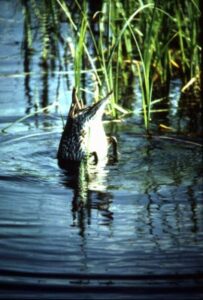
Bombing at Eagle River Flats
On the outskirts of Anchorage sits the Eagle River Flats, a marshland created by Eagle River emptying into upper Cook Inlet. These 2,500 acres provide key habitat for numerous birds, including dabbling ducks and sandhill cranes. Thousands of birds rely on the Flats during their fall and spring migrations.

Aerial view of the rich estuary of Eagle River Flats. Photo courtesy of the Army Corps of Engineers.
Beneath the surface of the marshland, however, lie fifty years of toxic contaminants from weapons training conducted by the U.S. Army. Starting in the 1940s, the Army used this area—which is within the Joint Base Elmendorf Richardson (JBER)—as a training ground for explosives. The explosives used prior to 1990 contained white phosphorus, an extremely toxic substance. The bombing caused white phosphorus from the explosives to become buried in the land area and sediment of the river.
In the early 1980s, the impact of this buried white phosphorous became evident. Hunters discovered a shocking number of duck carcasses strewn across the Flats. It turned out that dabbling ducks were stirring up and ingesting the phosphorus when feeding on aquatic plants. The Army suspended bombing in the Flats while evaluating how to best deal with the contamination and prevent large-scale bird mortality. The solution—successful for over two decades—was to stop using bombs with white phosphorus and to restrict bombing activities to times when the Flats were covered with sufficient ice to prevent stirring up more of the toxic materials.

Dabbling ducks reach underwater to feed tipping their butts out of the water. Army Corps of Engineers photo.
Over time, as the extent of the contamination became clear, the Flats were listed as a Superfund site. Still, problems continued and in the early 2000s, Trustees for Alaska filed a lawsuit on behalf of numerous groups and individuals to pressure the Army to clean up the site and prevent further contamination. This litigation resulted in a settlement agreement where the Army committed to certain cleanup actions, monitoring, and protective firing restrictions.
Despite this, the Army began an environmental review process in 2007 to resume year-round weapons training at the Flats. State and federal wildlife agencies have expressed serious concern about the environmental consequences of this proposal, noting that it would uncover contaminants currently buried in the sediment, which would then be assessable to foraging birds. In response to this pressure, the Army never finalized its analysis and winter-only firing restrictions remain in place to this day.

An unexploded bomb sits on top of the wetlands in the Eagle River estuary. Army Corps of Engineers photo.
And then this spring, the Army conducted bombing exercises on the Flats, without completing any of the environmental analysis required by Federal law. Trustees contacted the Army, raising concerns about their lack of compliance. Although the Army stopped further training exercises in response to Trustees’ inquiries, it decided to reinitiate its environmental analysis to allow it to legally resume year-round bombing on the Flats. Trustees is currently working with Alaska Community Action on Toxics and Cook Inletkeeper to ensure that winter-only firing restrictions remain in place to protect birds on their important fall and spring migrations.
LEARN MORE:
The Army’s 2010 DEIS for Resumption of Year-Round Firing
US Fish and Wildlife’s Comments on the 2010 DEIS
US Fish and Wildlife’s 2007 Scoping Comments


